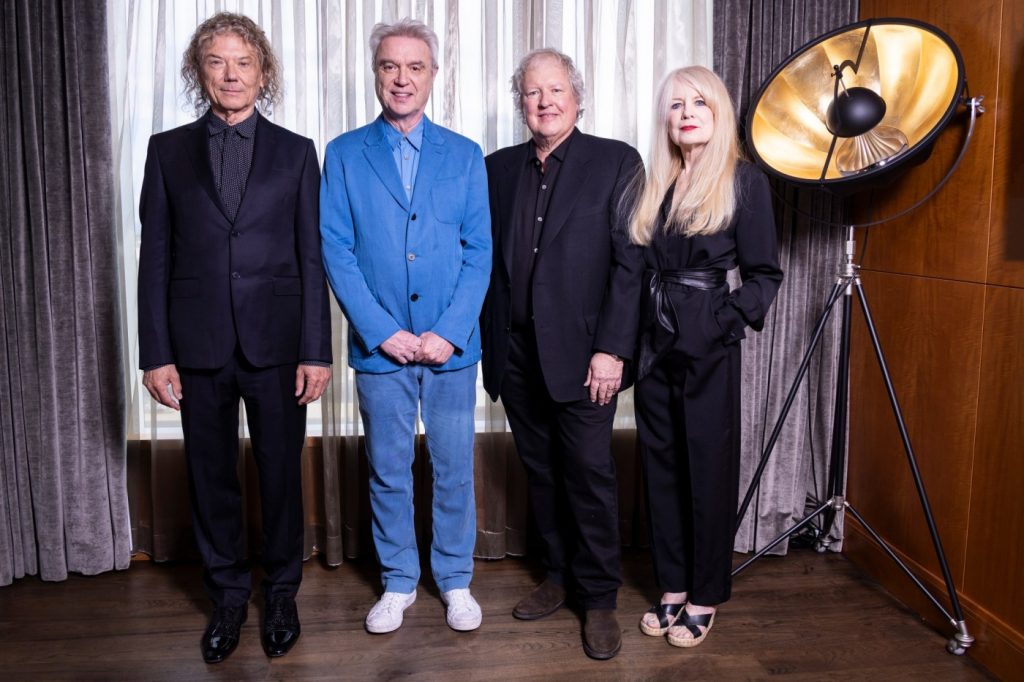A long time ago, in a record store far, far away — well, not that far, but it WAS decades ago — I walked out of Cymbaline Records on Center Street with three albums: The Pretenders, The Ramones “Rocket to Russia” and something called “Talking Heads ’77.” I had no idea those three would forever be part of my desert-island collection. (You know the drill: You’re hypothetically stuck on a desert island with only a volleyball to talk to, so what records do you take?)
The Talking Heads were like nothing I’d ever heard before. They were lumped in with punk, but there were no screaming guitars or punky angst. So how to describe The Talking Heads? I recently went right to one of the sources: Founding member Jerry Harrison, who played keyboards and lead guitar in the band.
In a phone interview, I talked to Harrison about the band’s early days, how they grew into one of the biggest bands in the world, and what led to their legendary concert film directed by Jonathan Demme, “Stop Making Sense.” The film will be shown at the UC Santa Cruz Quarry Theater July 13. And Harrison will be playing the Talking Heads’ “Remain In Light” track-by-track, along with some other tunes from his old band, on Aug. 16.
Harrison agreed that their first album was unique. “We got that a lot,” he said. “It was a unique time for music. When we first came out, a lot of people had no idea what our influences were. Then we covered (the Al Green classic) ‘Take Me to the River’ and people realized that R&B was our big influence.” Harrison came to the band from Jonathan Richman’s Modern Lovers — another pioneering outfit from that period. “To me, coming from that band, there was an appreciation for straightforward melodies and not being blues-influenced.”
They cut their teeth at the legendary CBGB nightclub in New York, sharing the bill with punk bands of the era including The Ramones, Blondie and Television. There was a thread connecting all that music. “This was the era of Emerson, Lake, and Palmer and Yes with their grandiose version of rock and roll,” Harrison laughed. “What everybody shared at CBGBs were unusually concise, short songs. The length of the songs was like an early Buddy Holly song or an early rock song with three to four minutes at the absolute longest.
“This also came out of the fact that CBGBs would have like five or six bands in a night. So you’d have a half hour to play. And The Ramones would do 15 songs. (under two minutes each). The Talking Heads also believed in that short and sweet ethos.”
Related Articles
Bay Area arts: 7 great shows and concerts to catch in the Bay Area
Karrin Allyson’s Bay Area tour: Brazilian tunes, Kenny Washington
These iconic ’90s acts have stopped fighting and started touring together
Travis Kelce joins Taylor Swift on stage at London Eras Tour show
Review: Megan Thee Stallion starts off strong then stumbles in San Francisco
They toured frequently as a quartet, with Harrison trading off keyboard and lead guitar, depending on the song. “The longer we played together, the more adept David and my guitar playing together became. We played off each other in a really good way. I would pick what instrument was best for each song and go back and forth and we would go from there.”
A few records in, their 1980 “Remain In Light” album was a bigger project. “When David and I were mixing the album, I realized that to play this right, we’d need another keyboard player, and another percussionist, and a second bass player. On the initial tour, we came on as a four-piece, then we slowly introduced the rest of the band. It was still one of the most amazing concerts we ever did because people were so shocked and surprised. It was built piecemeal onstage as the concert progressed.
That building-a-band effect is what was chronicled in the 1984 award-winning concert film, “Stop Making Sense.” Recorded over three nights in a Los Angeles theater and spearheaded by director Jonathan Demme, a casual Google search tells you it is widely regarded as one of the best concert films ever made. For its 40th anniversary, Harrison remixed all of the audio, so it would best accommodate the latest sound systems in theaters.
There’s also a local connection to the “Stop Making Sense” reissue. I spoke with filmmaker James Mackoski recently. He was raised in Aromas, studied film at UCSC, and worked as an archivist in Los Angeles. After a few years, he wanted to get back to the Bay Area and was fortunate in 2002 to be hired by Francis Ford Coppola to “rein in their collection and get it properly catalogued.” James soon worked on the preservation of films including “The Outsiders” and “Cotton Club.”
In the case of “Stop Making Sense,” James said, “I was asked by H14 Studios, whom I worked with 10 years previously, to supervise the restoration of the film.” The first challenge was FINDING the actual negative — it’s been 40 years, remember. James and his team called “everywhere, asking ‘where did the original camera negative go to? We even went through warehouses in L.A. that were closing down. We eventually found what we needed in a warehouse in Burbank. And it hadn’t been touched in 30 years!”
The restored 4K and remixed release of “Stop Making Sense” will be shown at UCSC’s Quarry Amphitheater July 13. And Jerry Harrison teams up with Adrian Belew (former guitarist with King Crimson and David Bowie, among others) and a full band at the theater on Aug. 16. Tickets for both events are available at quarryamphitheater.com.
Michael Gaither is a local performing songwriter, DJ at KPIG radio, and in a previous life was also a writer for The Santa Cruz Sentinel.


